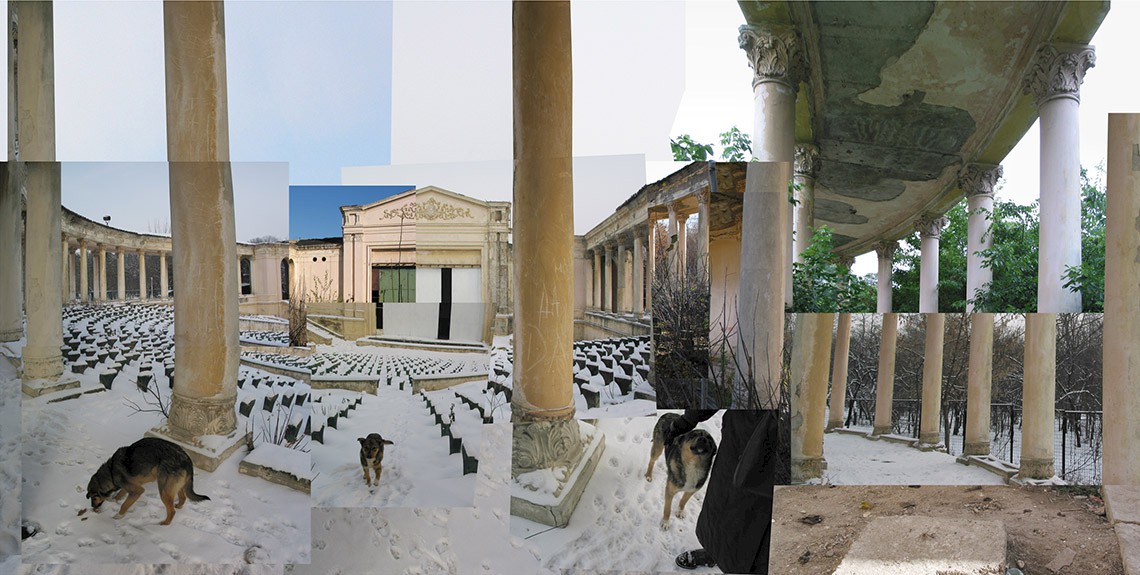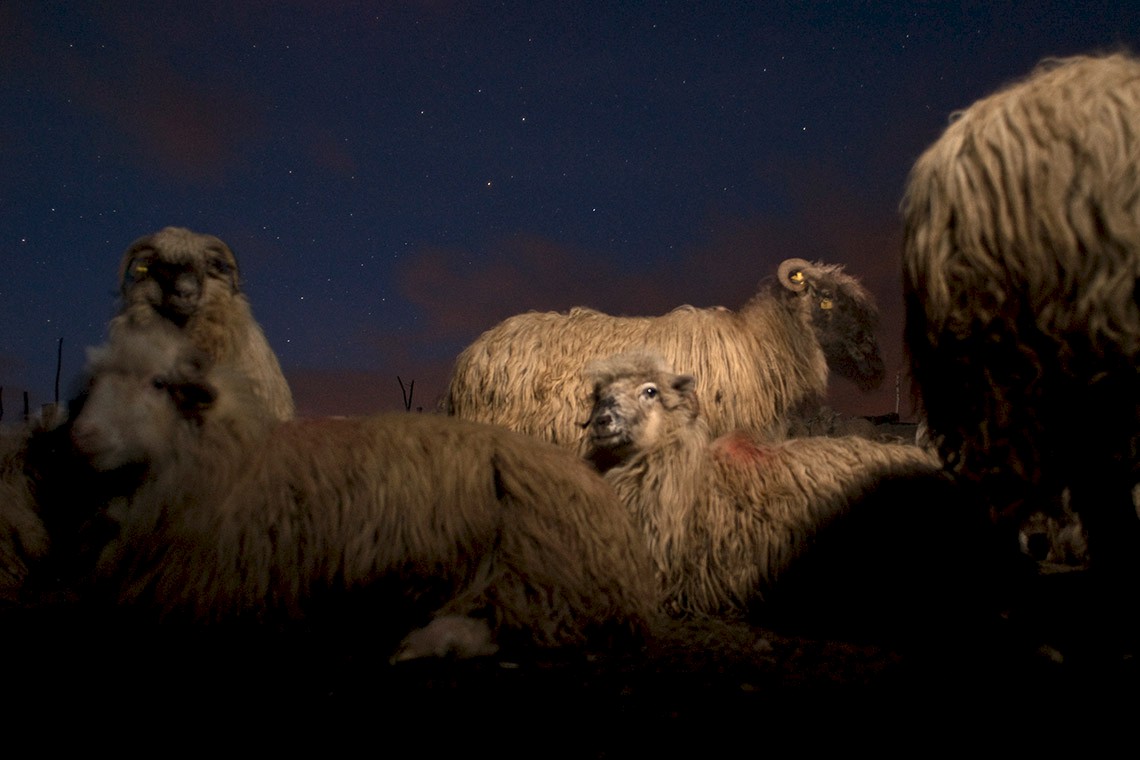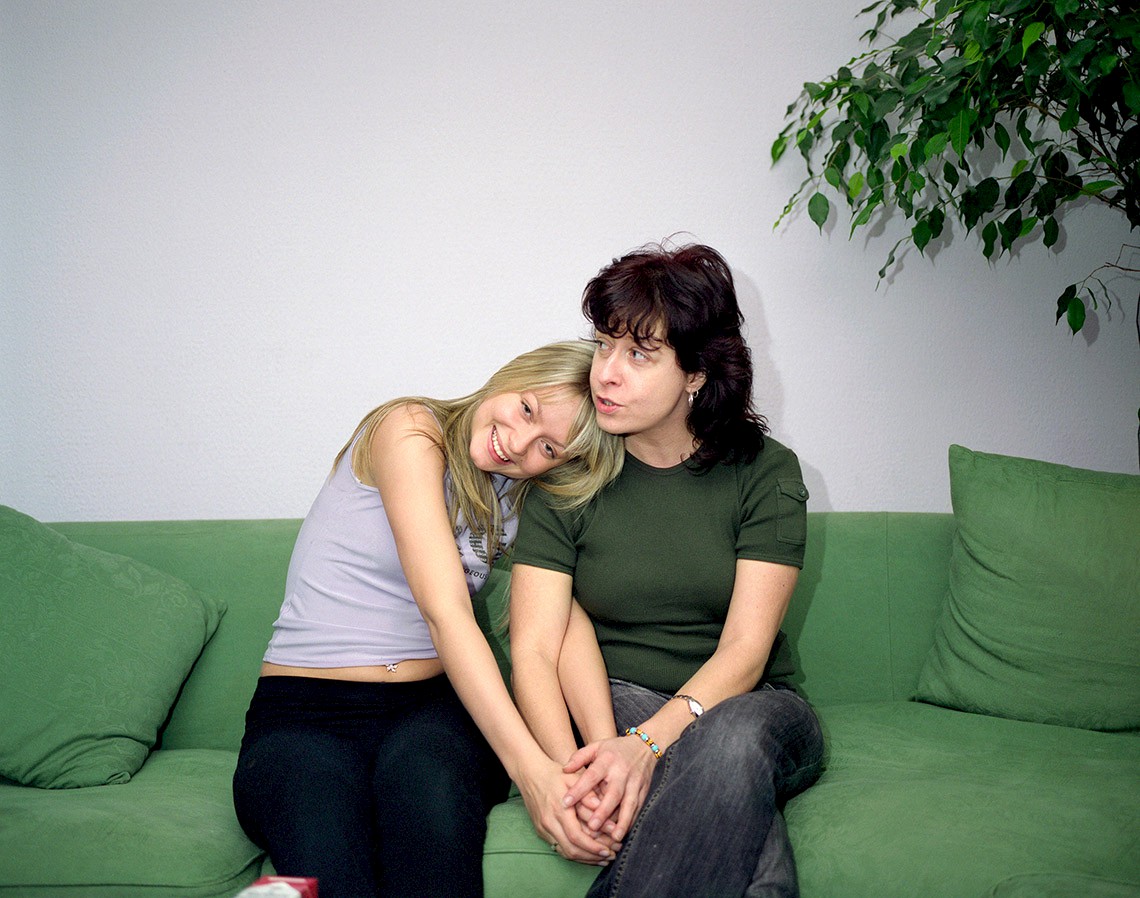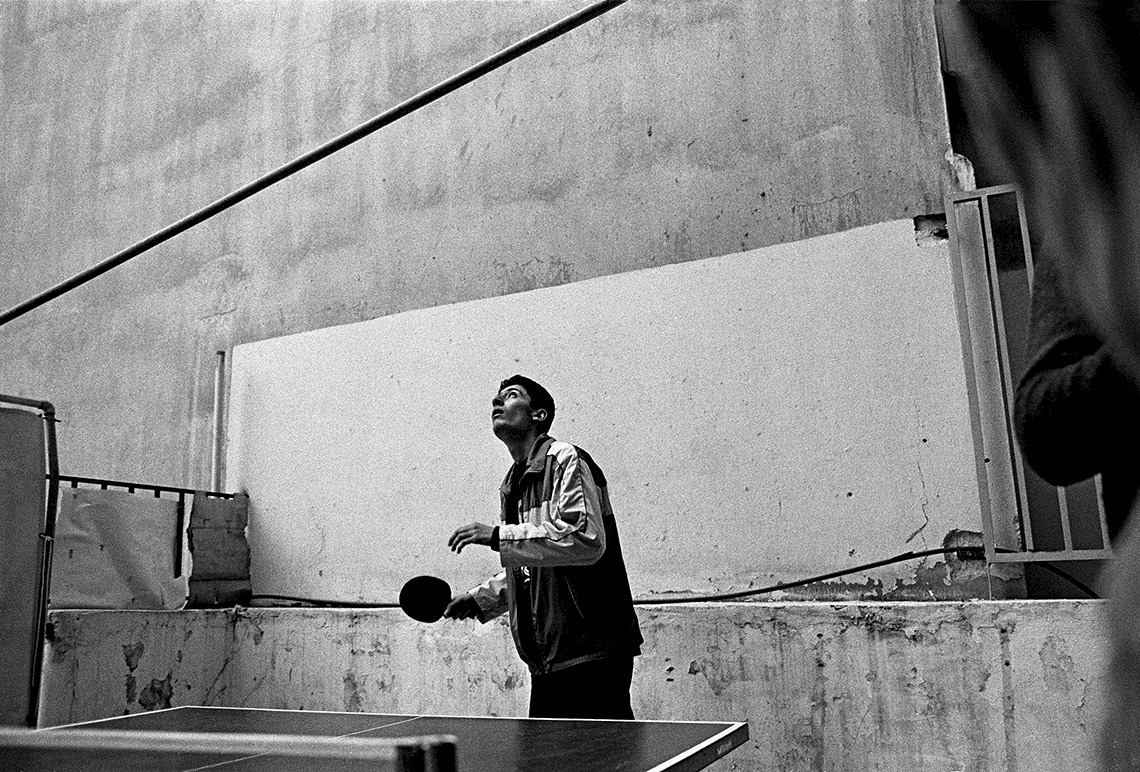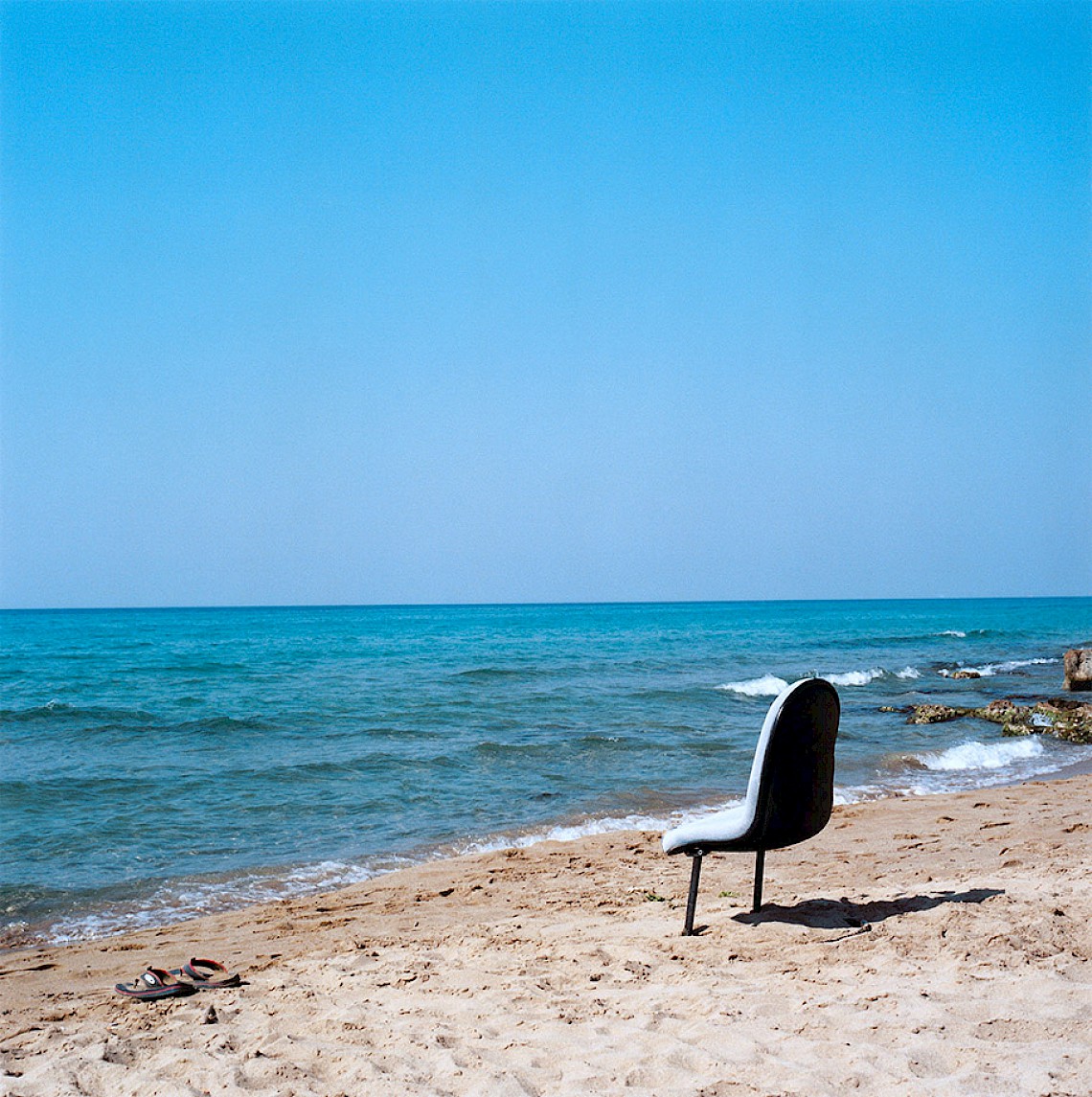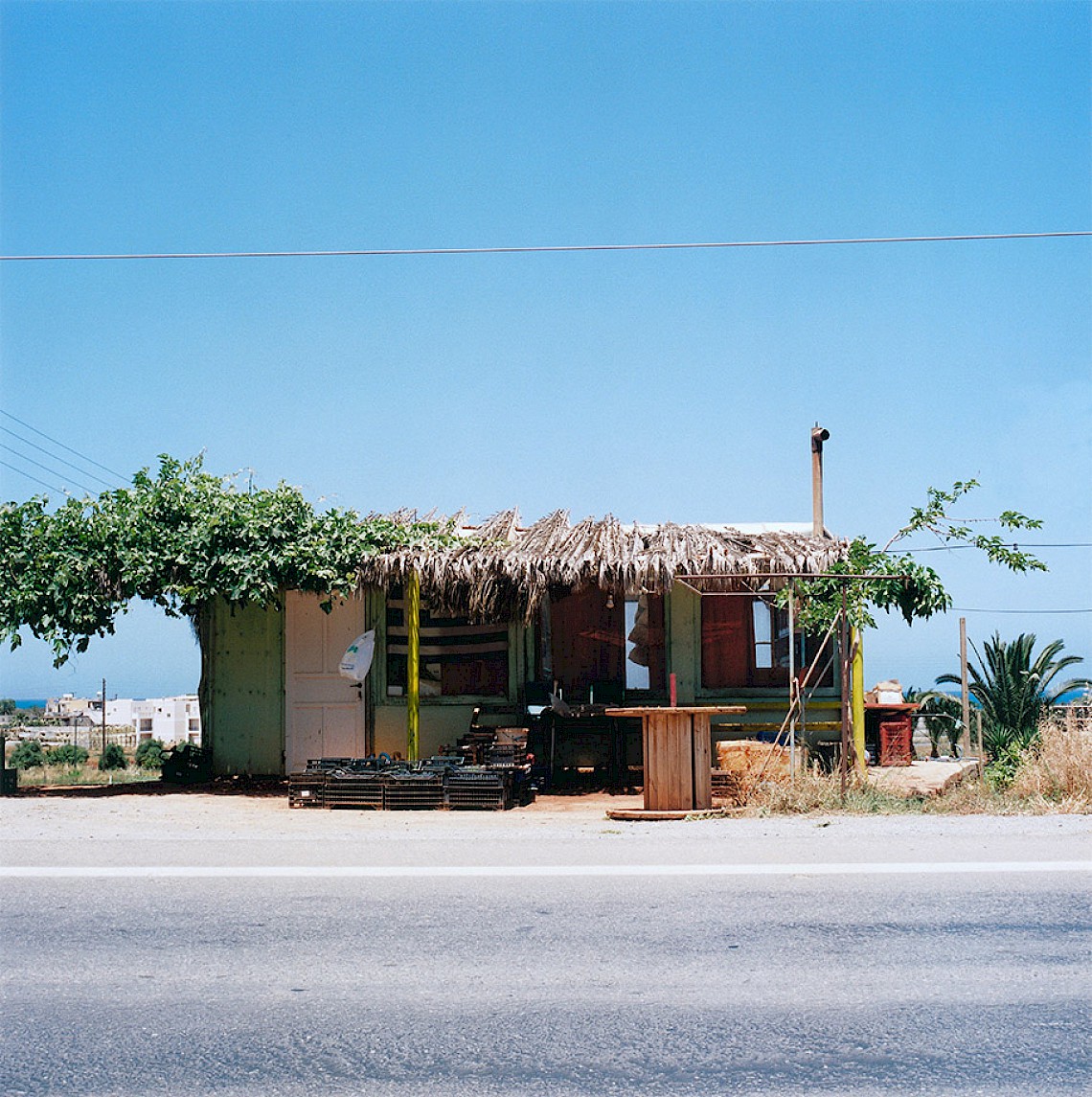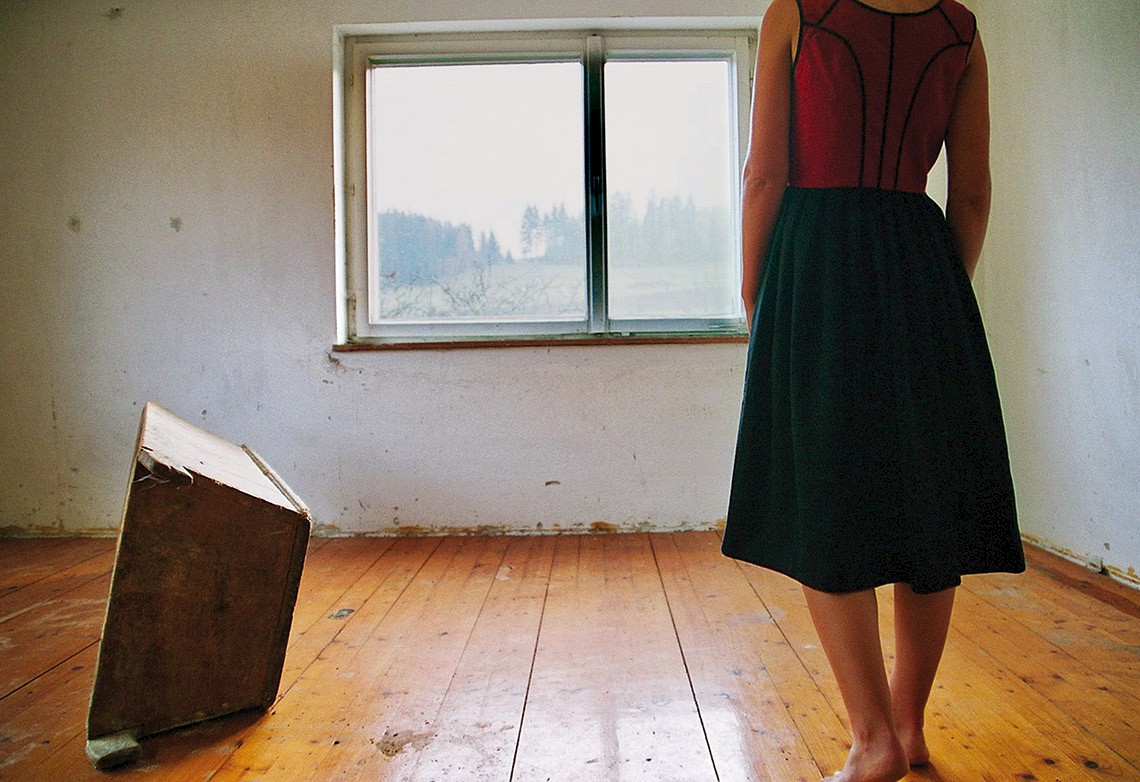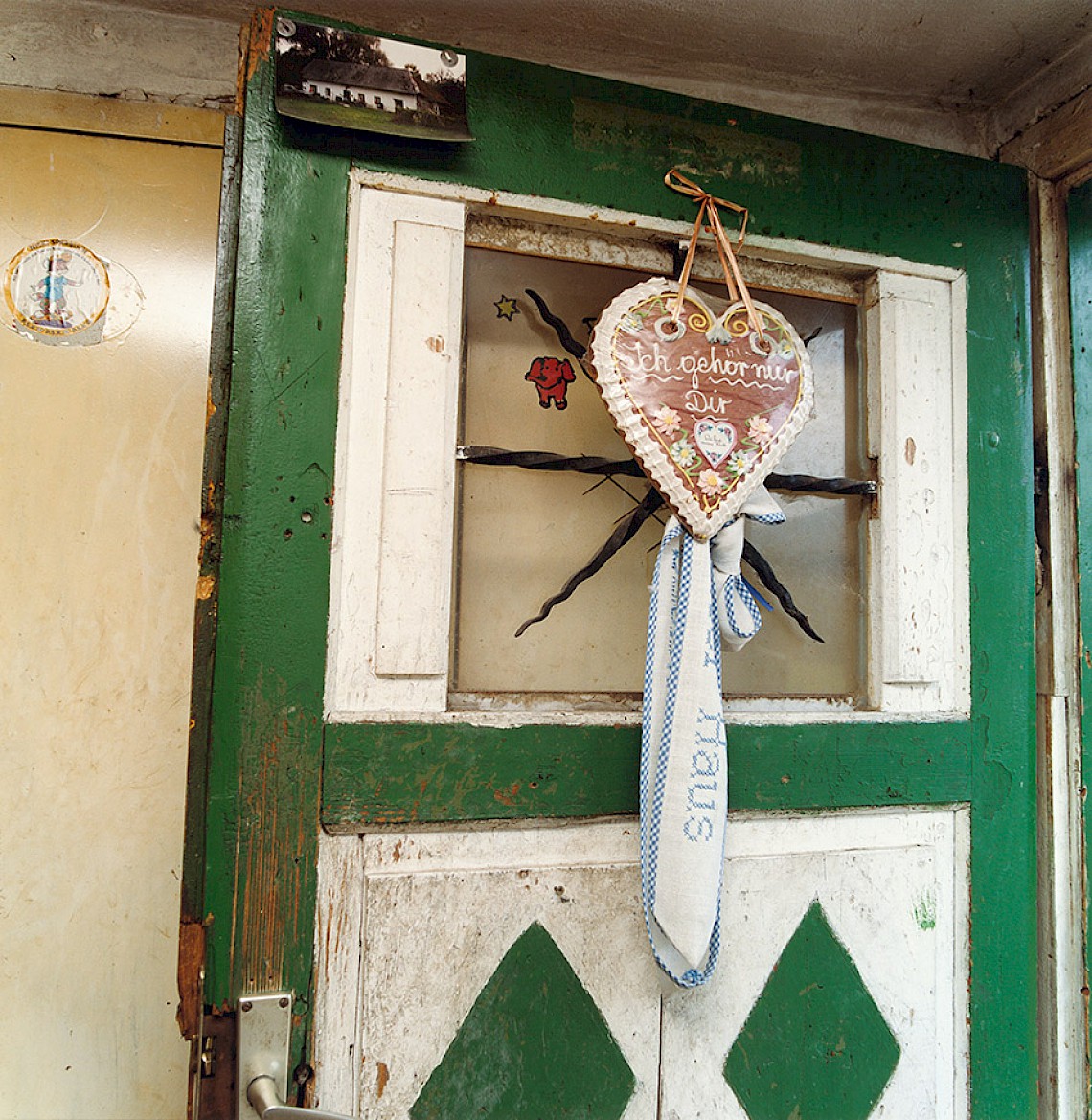ECB Award
Wie leben wir die unterschiedlichen Kulturen? Wie werden sie im Miteinander wahrgenommen? Wie können im vereinten Europa Identitäten gewahrt und dennoch gemeinsame Strukturen gelebt und kommuniziert werden?
Den Medien kommt in diesem Prozeß eine besondere Bedeutung zu. Sie agieren gewissermaßen auf zwei Ebenen. Überall wo Menschen leben, agieren sie in Zeichen, in Zeichensystemen, in ganz konkretem Handeln. Es ist der Lebensalltag. Überlagert wird dieser Alltag von den „globalen“ Medien: Zeitungen, Illustrierten, Radio, Fernsehen, Internet etc. im Lande und über die Grenzen einzelner Länder hinaus. Mehr als die Sprache sind es die Bilder, wesentlich technisch erzeugte und übertragene Bilder.
Die Fotografie ist als zeitgenössisches Medium beinahe wie eine Sprache zu handhaben. Bilder jedoch werden anders als die vielen gesprochenen Sprachen ohne Sprachbarrieren verstanden. Dennoch liegen auch Bildern spezifische kulturelle Sehweisen zugrunde. Auch der Gebrauch der Bilder ist unterschiedlich sowie ihre Beziehung zur Wirklichkeit. Fotografische Bilder dokumentieren und schaffen mediale Wirklichkeit unter ästhetischen Bedingungen, die durch kulturelle Mentalitäten höchst differenziert vorgetragen werden. Die Geschichte der Fotografie hat viele Beispiele gesellschaftlich engagierter Fotografen zu bieten, deren Bilder nicht nur politische Folgen hatten, sondern auch stilprägend für die visuell orientierten Medien wurden. Der Amerikaner Lewis H. Hine dokumentierte die Kinderarbeit in Amerika (die Folgen: Schutz der Kinder) und im Auftrag des Roten Kreuzes die Lebensverhältnisse der Armen in osteuropäischen Ländern nach dem ersten Weltkrieg. Oder das wohl größte Projekt: die fotografische Dokumentation der prekären wirtschaftlichen Lage der Landbevölkerung im Süden der USA durch die Farm Security Administration (FSA) in den dreißiger Jahren, an der die berühmtesten Fotografen der damaligen Zeit beteiligt waren. Aus anderem Anlaß fotografierten der Franzose Henri Cartier-Bresson und der Schweizer Robert Frank in sehr unterschiedlicher Art in den Vereinigten Staaten. Die publizierten Bücher wurden „Spiegel“ für die Amerikaner und visuelle Interpretation eines damals noch weit entfernten Landes für die Europäer. Der Schweizer René Burri hat in den fünfziger Jahren in Deutschland fotografiert. Sein Buch über die Deutschen ist inzwischen ein historisches Dokument „typisch“ deutscher Verhaltensweisen in einer Zeit der Suche nach neuen Formen der Identität. Derartige Projekte könnten durchaus Vorbildcharakter haben Die Fotografie ist das Medium eines von der Europäischen Zentralbank geförderten Projekts zum kulturellen Austausch. Der „ECB Annual Photography Award“ wird jährlich ausgeschrieben und wendet sich an alle Generationen von FotografInnen. Wie sehen Fotografinnen und Fotografen ihre eigene Kultur oder die Kulturen der anderen? Unter dieser Fragestellung können sich die Fotografen ihre Konzepte und Themen selbst formulieren. Ein solches Projekt setzt auf Qualität, geht von einem anspruchsvollen Niveau aus, wie es heute durch die künstlerische Fotografie vorgegeben wird. Diese Form der Fotografie experimentiert mit Ausdrucksformen, sucht nach neuen Sehweisen einer zeitgemäßen visuellen Kommunikation.
Im Unterschied zur Pressefotografie, die dem Tagesgeschehen folgt und durch Auftraggeber fixiert ist, sollte das Projekt durch „freie“ Beobachtung und einen „subjektiven“ Blick geprägt sein. Aus der thematischen Dichte heraus sollten Bilder entstehen, die vor allem den flüchtigen Fernsehbilder eine Bildkultur entgegensetzen. Die Kriterien für künstlerische Fotografie ergeben sich aus Aspekten, die nicht nur durch die europäische Kunsttradition geprägt sind, sondern gerade auch durch unterschiedliche zeitgenössische Formen ästhetischer Muster und durch spezifische, der jeweiligen Zeit entsprechend relevante Themen. Diese Unterschiede machen die Dimensionen eines solchen Projekts aus. Darüber hinaus ist das Dokumentarische, Reportagehafte oder Narrative Bestandteil der Fotografie. Dem schnellen Wandel vielfältiger Erfahrungen verschiedener Generationen und Völker in Europa könnte in den Fotografien ein visuelles Gedächtnis geschaffen werden. Was zeitgenössisch als Spiegel fungiert, wird mit der Zeit zu einem historischen Dokument. Schon nach kurzer Laufzeit des Projekts entsteht ein Fundus zeitgenössischer Kunst, Grundstein für eine Kunstsammlung der Europäischen Zentralbank.
Prof. Claudio Hils
Kurator des ECB Annual Photography Award und
Prof. Manfred Schmalriede
- Romania (2009)




1. Preis: Nicu Ilfoveanu / „Steampunk Autochrome“
Nicu Ilfoveanu nützt eine spezielle Kameratechnik, um Bilder als „Veduten der Gegenwart“ zu erzeugen. Landschaftsausschnitte und Industrieanlagen werden in fotografischen Kompositionen von Farbe und Licht wie atmosphärisch aufgeladene Malerei präsentiert. Das Aufnahmeverfahren erzeugt gleichzeitig jedoch auch einen irritierenden Eindruck. Statt ästhetischen Entrückungen und zeitlichen Entkoppelungen werden landschaftliche und gesellschaftliche Transformationsprozesse auf einer Metaebene reflektiert. Zunehmend wandelt sich der erste Bildeindruck: Der melancholische Charakter kippt in ein scharfes Bild der Gegenwart, in der die eigentliche Realität gerade durch die Ausklammerung spürbar wird. Das in den Fotografien Nicu Ilfoveanus erlaubte Maß ästhetischer Schönheit verklärt sich in ihr Gegenteil und entlarvt die Sehnsucht nach inneren Bildern ihres utopischen Charakters.



2. Preis: Iosif Kiraly / „RECONSTRUCTIONS“
Iosif Kiraly nützt die Möglichkeiten der digitalen Bildbearbeitung, um unterschiedliche Aufnahmen an konkreten Orten zu neuen Bildgefügen zusammenzusetzen. Jedes Bild erweist sich dadurch als Konstruktion von Details, die der Künstler zwar alle an einem Ort tatsächlich fotografierte, jedoch in dieser speziellen Konstellation eigens kombiniert. So entstehen Kompositionen, in denen sich mehrere Zeitebenen überlagern. Unterschiedliche Realitäten werden durch das künstlerische Verfahren in einer simultanen Konstellation zusammengeführt. Als Bildkonstruktionen werden gesellschaftliche und politische Zustände durch den Künstler dekonstruiert. Seine Aufnahmen von öffentlichen Plätzen, seine Auseinandersetzung mit Architekturruinen und seine Dokumentation von theatralischen Aufführungen fragmentieren nationale Symbole und gesellschaftliche Zustände und fördern zudem Nachdenprozesse über Erinnerung und deren Konstruktion.




3. Preis: Dragos Lumpan / „The last transhumance“
Knapp eineinhalb Jahre fotografierte Dragos Lumpan eine Hirtenfamilien, deren Schafe sich in den dabei entstandenen Aufnahmen von nahezu archaischer bzw. symbolischer Wirkung erweisen. Nach wie vor gehören Schafherden zu einer nicht nur in Rumänien existierenden ökonomischen Realität, die trotz ihrer langen Geschichte und vielfältigen kulturellen Einbettung nahezu exotisch erscheint. Dragos Lumpan lässt den Mythos neuerlich aufleben. Er zeigt die Herde als Maße und schildert die Lebensweise der Hirten. Allerdings setzt der Künstler sehr subtile Schnitte, die jede romantische Verklärung in ihr Gegenteil verkehren: Lichter der nahen Großstadt, das Leuchten des eigenschalteten Radios und der als Unterkunft dienende Wohnwagen erzeugen Bruchlinien, die sich messerscharf durch das gesellschaftliche Leben ziehen. Damit werden die Bilder auch zu Metaphern einer tiegreifenden Umwälzung der rumänischen Bevölkerung.
- Europe (2008)




1. Preis: Lucia Nimcova „Unofficial“
Lucia Nimcova‘s fotografische Serie „Unofficial“ ist eine vielschichtige Auseinandersetzung mit einer Bild- und Alltagsästhetik in einem ehemals kommunistischen Lebensumfeld. Dabei werden ausgewählte Bilder re-inszeniert. Zwischenzeitlich gealterte Menschen schlüpfen noch einmal in Bildsituationen, die eine bestimmte Alltagsästhetik und Politik der visuellen Kultur transportieren. Durch den Grad der Inszenierung schafft die gesamte Serie eine repräsentationskritische Distanz, die historischen Bildern ohne Zynismus begegnet. Stattdessen werden Bilder eines kollektiven Gedächtnisses auf ihre spezifische Erinnerungsqualität für eine jüngere Generation hin überprüft.




2. Preis: Wytske van Keulen „Andzelika“
Die Serie „Andzelika“ handelt von einer jungen Polin. Seit letztem Jahr können polnische Angestellte in den Niederlanden ohne Einschränkungen arbeiten. Andzelika‘s Eltern, sowie viele Polen, werden diese Möglichkeit ergreifen. Sie sind kurz davor sich endgültig in einem neuen Land niederzulassen. Die siebzehnjährige Andzelika muss eine Entscheidung treffen. Wird sie Ihren Eltern folgen oder in Ihrem Heimatland bleiben? So erzählen die Bilder nunmehr von beiden Orten. Sie zeigen Andzelika, ihre Familie, ihr gemeinsames Leben. Sie vermitteln einen Eindruck von einer Situation, die sich zwischen zwei Systemen in einem gemeinsamen Europa gleichzeitig als Chance, Realität und Zerissenheit erweist.




3. Preis: Raphael Dallaporta „Domestic Slavery“
“Domestic Slavery“ ist ein fotografisches Projekt, das Formen moderner Sklaverei in Europa nachspürt. Es geht dabei um konkrete Schicksale von Menschen und tatsächliche Orte des jeweiligen Verbrechens. Durch die Kombination von Texten und Bildern entstehen Berichte, die hinter einer Fassade der Normalität Tatorte offenbaren und das konkrete Schicksal von Menschen dokumentieren.
- Greece Today (2007)




1. Preis: Vagelis Georgas
[EN] The photographs of Vagelis Georgas form part of a long-term work in which Athens is portrayed as a living space and stage on which the daily routine of contemporary life unfolds. His photographs explore the relationship between people and urban landscape, which helps to shape the image of public space in a city undergoing constant transformation. In this particular section of his work, the photographs depict scenes taking place in the streets around Omonia Square, as well as religious rituals and cultural events organised by immigrants in contemporary Athens.




2. Preis: Myrto Papadopoulos
[EN] The photographs of Myrto Papadopoulos form part of a broader photographic work extending from the region of Evros to the islands in the South Aegean. The photographs presented here have been taken mainly in Didymoteixo, a town in Thrace, in the north-east of Greece. The people portrayed are Muslims and immigrants of Greek citizenship, originating from the countries of the ex-Soviet Union. They live on the fringes of the city and of social life, and despite their tough living conditions still retain their own rich cultural heritage.




3. Preis: Angeliki Svoronou
[EN] The photographs of Angeliki Svoronou record a journey in the country of tourist “development” and “exploitation”. Landscapes devoid of people, with the blue and white national flag waving proudly over the white sunshades behind stacked deck-chairs.The flag reminds us of Greece and the beach umbrellas of holidays. Two symbols co-existing in the arena of consumption and globalisation, each carrying its own mythology.
- Austria Today (2006)




1. Preis: Gerlinde Miesenböck „Land_Sterben“
Gerlinde Miesenböck reagiert fotografisch auf eine Form der ländlichen Kultur in Österreich.
Indem sie selbst in den Fotografien auftaucht, koppelt sie eine Befragung von Tradition und Stereotypen der ländlichen Kultur mit einer Selbstreflexion, die insgesamt eine poetische Stimmung stiftet.
Fotografisches, Filmisches und Narratives verschmelzen in einer elegischen Geschichte des Verlusts von Heimat und einer bäuerlichen Vergangenheit, die jenseits einer übertriebenen Romanisierung und eines Gefühls der Betroffenheit Orte in einen Zustand zwischen Bild und Wirklichkeit entrückt.



2. Preis: Tatjana Lecomte „Fallschirmspringerwand“
Die Fotografien sind Teil eines laufenden Projektes, bei dem die Künstlerin Landschaft im Umfeld von Konzentrationslagern untersucht. Die „Fallschirmspringerwand“ befindet sich im Steinbruch von Mauthausen in Oberösterreich.
Sie erhielt Ihren Namen, der auf die Praxis verweist, Menschen diese Felswand herabzustoßen, von SS-Männern. Die Fotografien zeigen die Spiegelungen auf der Wasseroberfläche und sind dann selbst noch einmal auf den Kopf gestellt. Vor allem durch diese Umkehrung erscheinen die Fotografien Lecontes als sensible Hinterfragung eines Österreichischen Geschichtsbildes.
Ohne Geschichte sind ihre Fotografien nicht auflösbar. Es geht somit um die Geschichte hinter dem Bild. Sie vermitteln die „liebliche“ Landschaft als Ort der Gewalt.



3. Preis: Paul Kranzler „Landjugend/Thomas R.“
Über einen längeren Zeitraum fotografierte Paul Kanzler einen jungen Mann. Das Porträt erlaubt das Eintauchen in ein Milieu, das den konkreten sozialen Raum eines Jugendlichen in einer ländlichen Situation vorführt.
Wiederholt wurden Aufnahmen des Mannes von Paul Kanzler mit Details aus dem unmittelbaren Lebensumfeld des Protagonisten gekoppelt. Die Bilder verraten eine intensive Auseinandersetzung des Fotografen mit seinem Modell.
Durch Details und Posen stellt Kanzler Fragen nach dem Verhältnis von Dokumentation und Inszenierung. Die soziale Analyse erhält dadurch eine Wirkung, die den zweiten Blick auf einen Menschen und sein Umfeld fordert. - Hungary Today (2005)



1. Preis: Dezso Tamas
[EN] The present: Hungary in 2005. What is Hungary today, and what is this “present”? The words and expressions most commonly used to describe it are “European Union”, “globalisation” and “information society”. The world is making enormous technological progress, yet at the same time and to the same degree, it is becoming smaller. This is what is meant by globalisation. We receive real-time information on events in any part of the globe, and in the twinkling of an eye, we can contact anyone anywhere: distances no longer exist. Never has Hungary faced such a challenge and such an opportunity as that now offered by technological development and history. Now is the time to create opportunities for the young and for future generations. The social and economic transition must be completed by a change in Hungarians´ way of thinking: knowledge and openness become an integral part of their lives. We must face the fact that when people´s lifestyles change, the structure of urban areas will change too. The current state of the environment cannot be regarded as an issue of minor importance. Society as a whole, and each individual within it, must act to ensure that we can hand down to the coming generation our local and global environment with a clean conscience. Hungary today: hopes and dreams. Children and young people who want to learn and get by, the middle-aged, weary old people and those left behind. People must learn new words such as confidence, success and creativity. We will need them in the future. (Dezso Tamas)



2. Preis: Peter Puklus
[EN] I collect portraits of the people around me. I explore and document those that are close to me in one way or another (I collect memories). Slowly I will get round to all of them. Whether showing relatives or friends, the end-product must always be a symbol of our relationship, the relationship among those appearing in the pictures, or the personal mystery, a reflection of which lights up in the subjects´ eyes. I capture moments enchanted by an expression of trust; this is intimacy and photography or, in other words, the history of love, friendship and identity. The pictures submitted form part of a long series, which is of course still in the making, still expanding. The first one was taken sometime this spring. The title of the series is: Intimacy – no title. I take complex pictures which incorporate the subject as well as their surroundings; part of the original concept was to emphasise the surroundings. Before taking a photograph, I normally visit my subjects´ home several times to select the best scene and time. I try to enter into their lives so that thy will be comfortable with my presence. I try to rearrange things as little as possible to preserve their intimacy and to present a real-life and authentic situation. The people appearing in the photos are friends and relatives. The title of the individual pictures is that of the person depicted. No title refers to the viewers of the collection as a whole, who will always remain outsiders. Whether the person in the picture is called Pista or Jozsi will make no difference to them. (Peter Puklus)


3rd prize: Lilla Szasz
[EN] I have selected five photos from two different series for the ECB´s photography competition. The two series contain images of, respectively, young female offenders and prostitutes. They are entitled “Portraits from a Female Juvenile Deliquent Institution” and “Joy girls”. Although the theme itself may imply a sociologist´s point of view, what motivated me most in making these images was to find out about the attitude of women of different social backgrounds to their womanhood, and how they find joy in their lives. The photos in “Portraits from a Female Juvenile Deliquent Institution” were taken in a Budapest institution which houses young female offenders and homeless mothers. In this series, I address the issue of how young women and mothers preserve their womanhood in such inhuman circumstances: how they try to brighten up their lives, and what little joys they derive from their confined world. Many of the photos are highly stylized. In a number of instances, the girls came up with their own ideas of how they would like to pose in the picture. Part of my underlying concept was to allow myself to be led by them, and to make sure that by giving them enough time they would enjoy our work together. I asked a number of the women to dress up, pose and use accessories as they thought would suit them best, or as they would like to see themselves in a photograph. I regard the institution itself as an important backdrop, yet my intention was not to give a sociological slant to the pictures. Today greater attention is devoted to the role of women in Hungarian society. The place of prostitutes has always been highly controversial as they are judged on the basis of their profession. The title “Joy Girls” is in effect a pun which reflects the following question: is it possible to find happiness in a situation where a woman is doomed to be humiliated, particularly in a society which rejects outright anything that does not fit into the box labelled “normal”? My intention with these photos was to show the audience that prostitutes are human beings just like anybody else, with the same joys and sorrows. (Lilla Szasz)
- Poland – My Country (2004)




1. Preis: Lukasz Trzcinski “Our foreigners”
[EN] Since the enlargement of the European union, Poland has become a more attractive destination for many refugees who wish to start a new life – a life they have saved by fleeing their own country. At the same time, the regulations regarding the treatment of foreigners have been made very strict. Every year, thousands of people come to Poland in the hope of receiving asylum. They wait for their applications for asylum to be processed, while their subsequent integration into their new surroundings is made more difficult by the low degree of social awareness of the polish people. Only a small number of people in Poland are able to distinguish the term “refugee” from ordinary immigration. This project is an attempt to give a face to concrete human dramas; it is an attempt to portray the problems with which refugees in Poland are confronted and to demonstrate difficulties surrounding their integration. At the same time, the project tries to show the potential that refugees have to offer us. Poland is their new country. Those that have been granted refugee status bind their fate with our country for good. While they are waiting for a positive response to their application for asylum, a process which can often take several years, they integrate so well into the society that they can no longer imagine living in any other country. Many of them are granted Polish citizenship, thus becoming compatriots with the same rights as us. This project is an attempt to define the position of refugees in society, an attempt to find an answer to the fundamental question of identity.It is an attempt to touch on the eternal question of what it means to belong to and function within society. (Lukasz Trzcinski)




2. Preis: Radoslaw Polak
[EN] The inspiration for this project was a modern Polish village and the desire to give it a fresh image. The village has often been photographed. The motif is seen as the very embodiment of Polishness. But to me, these pictures lack a modern, positive image. The aim of my work was to create an image of the Polish farmer that differs sharply from the negative stereotype to be found in the media (the primitive bumpkin manning a roadblock). It was also my aim to introduce this image into the aesthetic of modern advertising. The cycle cannot be described as a documentary, but rather a mise en scene in which the farmers are seen against the background of their natural environment, but have been spruced up by a stylist an a make-up artist. The idyllic landscape of the Klodzko Valley (Sudeten mountains) forms the background to these photos, punctuated by polish agricultural equipment. I see Poland as an agricultural country in which the links between man and nature, as well as nature itself, are still of great value, and this is how I wish to present my country in Europe. (Radoslaw Polak)




3. Preis: Beata Frysztacka
[EN] I see myself as a portraitist and explain all topics through people. After all, Poland is the people who live there. There are many different people: beautiful, interesting, young and old, experienced and inexperienced. Various different people sat individually for my photos. Each of them wore, in their own way, the same white blouse and the same red trousers. I wished to give the “trying on” of the same clothes symbolic significance. Even the blouse was cut in a feminine style – which is only logical, since out Poland is feminine. And the trousers? Well, in Poland most women wear trousers. My models stand in a relaxed pose, in clothes which are not always a perfect fit. The white and red of the Polish flag and Poland itself make their presence felt only discreetly. They are not a perfect fit for everyone, some feel more at ease in them than others. My Poland tends toward the ordinary – devoid of pathos (hence the fisherwomen) and subject to fashion and trends (as can be clearly seen from the style of the blouse). I believe that Poland is reflected in the hearts and minds of the people in my portraits. (Beata Frysztacka)
- Publikationen
ECB Annual Photography Award: Romania
European Central Bank, Frankfurt am Main, 2009
ISBN 978-92-899-0609-8
ECB Annual Photography Award: Europe
European Central Bank, Frankfurt am Main, 2008
ISBN 978-92-899-0296-0Deutscher Fotobuchpreis – Auswahltitel 2008

ECB Annual Photography Award: Greece today
European Central Bank, Frankfurt am Main, 2007
ISBN 978-92-899-0203-8
ECB Annual Photography Award: Austria today
European Central Bank, Frankfurt am Main, 2006
ISBN 92-9181-922-1
ECB Annual Photography Award: Hungary Today
European Central Bank, Frankfurt am Main, 2005
ISBN 92-9181-855-0
ECB Annual Photography Award: Poland – my country
European Central Bank, Frankfurt am Main, 2004
ISBN 92-9181-718-X
- Ausstellungen
- 2010
- „Romania“, Europäische Zentralbank, Frankfurt, DE
- „Romania“, National Museum of Contemporary Art, Bukarest, RO
- 2008
- „Europe“, Photokina, Köln, DE
- 2007
- „Austria Today“, Galerie Westlicht, Schauplatz für Fotografie, Wien, AT
- 2006
- „Austria Today“, Fotoforum International, Frankfurt, DE
- „Europe“ | Deutscher Fotobuchpreis – Auswahltitel 2008
- Stuttgarter Buchwochen, Haus der Wirtschaft, Stuttgart, DE
- Regierungspräsidium Karlsruhe, Karlsruhe, DE
- Internationale Bodenseemesse, Friedrichshafen, DE
- Frankfurter Buchmesse, Frankfurt, DE






